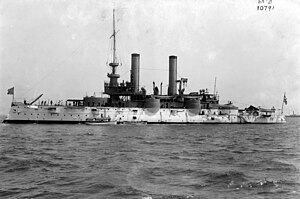 Iowa early in her career
| |
| History | |
|---|---|
| Name | Iowa |
| Namesake | Iowa |
| Builder | William Cramp & Sons, Philadelphia |
| Laid down | 5 August 1893 |
| Launched | 28 March 1896 |
| Commissioned | 16 June 1897 |
| Decommissioned | 30 June 1908 |
| Recommissioned | 2 May 1910 |
| Decommissioned | 23 May 1914 |
| Recommissioned | 23 April 1917 |
| Decommissioned | 31 March 1919 |
| Stricken | 27 March 1923 |
| Fate | Sunk as a target ship, 23 March 1923 |
| Class overview | |
| Preceded by | Indiana class |
| Succeeded by | Kearsarge class |
| General characteristics | |
| Type | Pre-dreadnought battleship |
| Displacement | |
| Length | |
| Beam | 72 ft 3 in (22.02 m) |
| Draft | 24 ft (7.3 m) |
| Installed power |
|
| Propulsion | |
| Speed | 16 kn (30 km/h; 18 mph) |
| Range | 5,140 nmi (9,520 km; 5,920 mi) at 10 kn (19 km/h; 12 mph) |
| Complement |
|
| Armament |
|
| Armor |
|
USS Iowa was a pre-dreadnought battleship built for the United States Navy in the mid-1890s. The ship was a marked improvement over the previous Indiana-class battleships, correcting many of the defects in the design of those vessels. Among the most important improvements were significantly better seaworthiness owing to her greater freeboard and a more efficient arrangement of the armament. Iowa was designed to operate on the high seas, which had been the impetus to increase the freeboard. She was armed with a battery of four 12-inch (305 mm) guns in two twin-gun turrets, supported by a secondary battery of eight 8-inch (203 mm) guns.
Upon entering service in June 1897, Iowa conducted training operations in the Atlantic Ocean before moving to the Caribbean in early 1898 as tensions between the United States and Spain over Cuba grew, leading to the Spanish–American War. The ship took part in the bombardment of San Juan, Puerto Rico, and then participated in the blockade of Cuba during the war, and after the Spanish cruiser squadron was found in Santiago de Cuba, she patrolled off the harbor to block their escape. In the Battle of Santiago de Cuba on 3 July, Iowa assisted in the destruction of three of the four Spanish cruisers. After the war, Iowa spent the next several years conducting routine training exercises, serving with the Pacific Squadron from 1898 to 1902, the South Atlantic Squadron until 1904, and the North Atlantic Squadron until 1906, when the latter two units were merged to form the Atlantic Fleet.
Iowa was modernized between 1908 and 1910; she thereafter served as a training ship for naval cadets from the United States Naval Academy and for naval militia crews. Removed from service in 1913 and decommissioned in 1914, she was reactivated after the United States entered World War I in April 1917, initially serving as a receiving ship and then as a training vessel and guard ship. She was decommissioned again in 1919, renamed Coast Battleship No. 4, and converted into a radio-controlled target ship. She was used in bombing experiments off the Virginia Capes in 1921 before being sunk as part of Fleet Problem I off the coast of Panama in March 1923 by the battleship USS Mississippi.